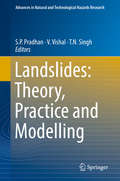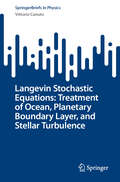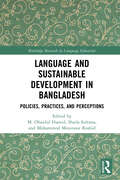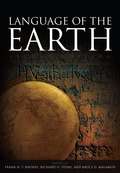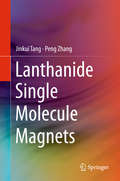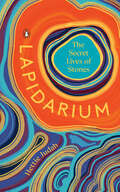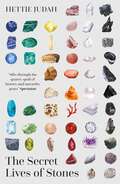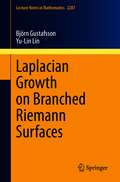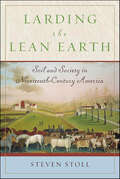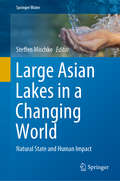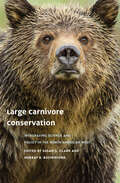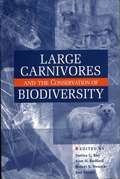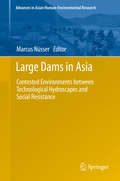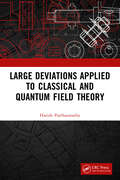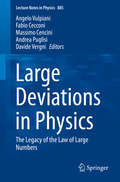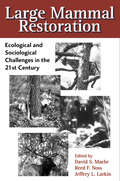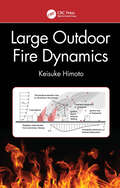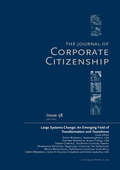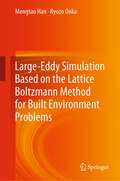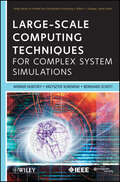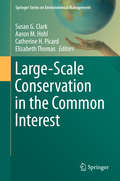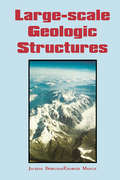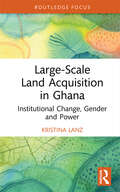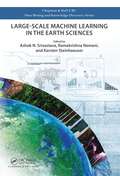- Table View
- List View
Landslides: Theory, Practice and Modelling (Advances in Natural and Technological Hazards Research #50)
by V. Vishal T. N. Singh S. P. PradhanThis book, with contributions from international landslide experts, presents in-depth knowledge of theories, practices, and modern numerical techniques for landslide analysis. Landslides are a reoccurring problem across the world and need to be properly studied for their mitigation and control. Due to increased natural and anthropogenic activities, chances of landslide occurrence and associated hazards have increased. The book focuses on landslide dynamics, mechanisms and processes along with hazard mitigation using geo-engineering, structural, geophysical and numerical tools. The book contains a wealth of the latest information on all aspects of theory, practices and modelling tools and techniques involved in prediction, prevention, monitoring, mitigation and risk analysis of landslide hazards. This book will bring the reader up to date on the latest trends in landslide studies and will help planners, engineers, scientists and researchers working on landslide engineering.
Langevin Stochastic Equations: Treatment of Ocean, Planetary Boundary Layer, and Stellar Turbulence (SpringerBriefs in Physics)
by Vittorio CanutoThis book derives, solves, and assesses the Langevin Stochastic Equations (LSE) as a tool for treating turbulent flows. Previous work has demonstrated the LSE's ability to successfully describe non-geophysical turbulent flows. However, this book specifically focuses on geophysical flows. Chapter I addresses the modeling of oceanic mesoscales (M) and sub-mesoscales (SM), while Chapter II discusses vertical mixing. The target audience for this book is advanced students and researchers interested in future climate change and the crucial role played by the ocean. One of the main challenges in describing oceanic M and SM is that they are governed by non-linear interactions for which no satisfactory model exists. Despite the unsuccessful attempts to describe non-linearity using the traditional Navier-Stokes Equations (NSE), heuristic models continue to be used. This has created a dilemma: while future climate projections need to be predictive, the heuristic treatment of M and SM lacks predictive power, leading to an internal inconsistency. The primary goal of this book is to demonstrate that the transition from NSE to LSE resolves this inconsistency, paving the way for a fully predictive treatment of M and SM. This advancement is crucial for providing future climate predictions with the credibility they require.
Language and Sustainable Development in Bangladesh: Policies, Practices, and Perceptions (Routledge Research in Language Education)
by Shaila Sultana Mohammod Moninoor Roshid M. Obaidul HamidThis book examines relationships between language and sustainable development in the context of Bangladesh. Following inclusive and multidisciplinary perspectives, these relationships are explored in mainstream education, teacher education, religious education and indigenous, ethnic minority and refugee settings. The contexts of development are also diverse which include the public sector, international non-government organisations, domestic work, tourism, and the environment.The book records voices of people from various linguistic, social, cultural, and demographic backgrounds, in urban, rural, and peripheral settings. It makes the language question visible in the manifold contexts of development where it has generally remained invisible. Giving visibility to language by referring to the Sustainable Development Goals (SDGs), the chapters embrace language and development in pluralistic ways and underscore their complex but undeniable relationships. The authors come from diverse backgrounds and bring plurality of genres, methods, insights, and implications.The volume is intended for students, academics, researchers, policy personnel, language practitioners, and other readers whose works and interests straddle language, development, and SDGs. It will benefit them by explicating language-sustainable development relationships in theoretical as well as practical ways, suggesting directives for policies and practices for linguistic and social justice, and equity and inclusion.
Language of the Earth: A Literary Anthology
by Bruce D. Malamud Richard O. Stone Frank H.t. RhodesMan's complex relationship to planet Earth is explored in this second edition of the landmark anthology edited by Frank Rhodes and Bruce Malamud. This volume provides a portrait of the planet as experienced not just by scientists, but by artists, aviators, poets, philosophers, novelists, historians, and sociologists as well. A unique collection that bridges the gap between science and humanities Contains writings by scientists, artists, aviators, poets, philosophers, novelists, historians, and sociologists including Charles Darwin, Dane Picard, Rachel Carson, John Muir, Mark Twain and Archibald Geikie Represents the human experience over the centuries, covering a span of 2,500 years Reflects the planet's extraordinary physical diversity The previous edition was voted one of the 25 'Great Books of Geology' by readers of the Journal of Geological Education "...this is a very worthwhile read, with something for everyone interested in geography, earth systems and geology, natural history or the general environment." Robert A. Francis, King's College London, Progress in Physical Geography
Lanthanide Single Molecule Magnets
by Peng Zhang Jinkui TangThis book begins by providing basic information on single-molecule magnets (SMMs), covering the magnetism of lanthanide, the characterization and relaxation dynamics of SMMs and advanced means of studying lanthanide SMMs. It then systematically introduces lanthanide SMMs ranging from mononuclear and dinuclear to polynuclear complexes, classifying them and highlighting those SMMs with high barrier and blocking temperatures - an approach that provides some very valuable indicators for the structural features needed to optimize the contribution of an Ising type spin to a molecular magnet. The final chapter presents some of the newest developments in the lanthanide SMM field, such as the design of multifunctional and stimuli-responsive magnetic materials as well as the anchoring and organization of the SMMs on surfaces. In addition, the crystal structure and magnetic data are clearly presented with a wealth of illustrations in each chapter, helping newcomers and experts alike to better grasp ongoing trends and explore new directions. Jinkui Tang is a professor at Changchun Institute of Applied Chemistry, Chinese Academy of Sciences. Peng Zhang is currently pursuing his PhD at Changchun Institute of Applied Chemistry, Chinese Academy of Sciences, with a specific focus on the molecular magnetism of lanthanide compounds under the supervision of Prof. Jinkui Tang.
Lapidarium: The Secret Lives of Stones
by Hettie JudahInspired by the lapidaries of the ancient world, this book is a beautifully designed collection of true stories about sixty different stones that have influenced our shared historyThe earliest scientists ground and processed minerals in a centuries-long quest for a mythic stone that would prolong human life. Michelangelo climbed mountains in Tuscany searching for the sugar-white marble that would yield his sculptures. Catherine the Great wore the wealth of Russia stitched in gemstones onto the front of her bodices. Through the realms of art, myth, geology, philosophy and power, the story of humanity can be told through the minerals and materials that have allowed us to evolve and create. From the Taiwanese national treasure known as the Meat-Shaped Stone to Malta&’s prehistoric &“fat lady&” temples carved in globigerina limestone to the amethyst crystals still believed to have healing powers, Lapidarium is a jewel box of sixty far-flung stones and the stories that accompany them. Together, they explore how human culture has formed stone, and the roles stone has played in forming human culture.
Lapidarium: The Secret Lives of Stones
by Hettie Judah'A delightful storybook . . . a portrait of our whole world created from the contents of the ground' Literary Review'A real cabinet of curiosities' Sunday TimesFrom the hematite used in cave paintings to the moldavite that became a TikTok sensation; from the stolen sandstone of Scone to the unexpected acoustics of Stonehenge; from crystal balls to compasses, rocks and minerals have always been central to our story.3,000 years ago Babylonians constructed lapidaries - books that tried to pin down the magical secrets of rocks. In The Secret Lives of Stones, renowned art critic Hettie Judah explores the unexpected stories behind sixty stones that have shaped and inspired human history, from Dorset fossil-hunters to Chinese philosophers, Catherine the Great to Michelangelo.Discover why alchemists sought cinnabar and sulphur. Unearth the mystery of the tuff statues of Rapa Nui, the lost amber room of Frederick of Prussia and the scandal of Flint Jack. Find out how a Greek monster created coral, moon rock explains the history of Earth's only satellite and obsidian inspired the world's favourite computer game. Stone by stone, story by fascinating story, The Secret Lives of Stones builds into a dazzling, epoch-spanning adventure through human culture, and beyond.
Laplacian Growth on Branched Riemann Surfaces (Lecture Notes in Mathematics #2287)
by Björn Gustafsson Yu-Lin LinThis book studies solutions of the Polubarinova–Galin and Löwner–Kufarev equations, which describe the evolution of a viscous fluid (Hele-Shaw) blob, after the time when these solutions have lost their physical meaning due to loss of univalence of the mapping function involved. When the mapping function is no longer locally univalent interesting phase transitions take place, leading to structural changes in the data of the solution, for example new zeros and poles in the case of rational maps. This topic intersects with several areas, including mathematical physics, potential theory and complex analysis. The text will be valuable to researchers and doctoral students interested in fluid dynamics, integrable systems, and conformal field theory.
Larding the Lean Earth: Soil and Society in Nineteenth-Century America
by Steven StollA major history of early Americans' ideas about conservationFifty years after the American Revolution, the yeoman farmers who made up a large part of the new country's voters faced a crisis. The very soil of American farms seemed to be failing, and agricultural prosperity, upon which the Republic was founded, was threatened. Steven Stoll's passionate and brilliantly argued book explores the tempestuous debates that erupted between "improvers," who believed in practices that sustained and bettered the soil of existing farms, and "emigrants," who thought it was wiser and more "American" to move westward as the soil gave out. Stoll examines the dozens of journals, from New York to Virginia, that gave voice to the improvers' cause. He also focuses especially on two groups of farmers, in Pennsylvania and South Carolina. He analyzes the similarities and differences in their farming habits in order to illustrate larger regional concerns about the "new husbandry" in free and slave states.Farming has always been the human activity that most disrupts nature, for good or ill. The decisions these early Americans made about how to farm not only expressed their political and social faith, but also influenced American attitudes about the environment for decades to come. Larding the Lean Earth is a signal work of environmental history and an original contribution to the study of antebellum America.
Large Asian Lakes in a Changing World: Natural State and Human Impact (Springer Water)
by Steffen MischkeDescribing the natural state of eight important lakes in Asia and the human impact on these lake ecosystems, this book offers a valuable reference guide. Over the past several decades the Aral Sea, Dead Sea, Lake Balkhash and other major lakes in Asia have undergone significant changes with regard to their size, water level, chemical composition, and flora and fauna. Most of these changes resulted from the loss of water from tributaries (now used for irrigation farming) or increasing consumption in local industries and households. However, significant human impacts may have begun as early as 2000 years ago. In addition to the three lakes mentioned above, Lake Sevan (Armenia), the Caspian Sea (Azerbaijan, Iran, Kazakhstan, Russia, Turkmenistan), Lake Issyk-Kul (Kyrgyzstan), and Lake Lop Nur (China) are discussed as the most prominent examples of changing lake ecosystems. In contrast, an example of an almost pristine lake ecosystem is included with the report on Lake Uvs Nuur (Mongolia). For each lake, the book summarizes its origin and early geological history, and reconstructs its natural state and variability on the basis of proxy records from drilled or exposed lake sediments that have accumulated since the last ice age. The frequently observed reductions in lake level and size during most recent decades led often to significant environmental impacts in the respective lake catchments including vegetation deterioration, soil erosion and badland formation, soil salinization or the formation of sinkholes.
Large Carnivore Conservation: Integrating Science and Policy in the North American West
by Susan G. Clark Douglas Clark D. Scott Slocombe David J. Mattson Rebecca Watters Avery C. Anderson Linaya Workman William M. Pym Micheal L. Gibeau Seth M. Wilson Gregory A. Neudecker James J. Jonkel J. Daniel Oppenheimer Lauren Richie David N. Cherney Christina MilloyStrategies for protecting wolves, mountain lions, and more—by taking the human species into account as well: &“Very valuable.&”—Journal of Wildlife Management Drawing on six case studies of wolf, grizzly bear, and mountain lion conservation in habitats stretching from the Yukon to Arizona, Large Carnivore Conservation argues that conserving and coexisting with large carnivores is as much a problem of people and governance—of reconciling diverse and sometimes conflicting values, perspectives, and organizations, and of effective decision making in the public sphere—as it is a problem of animal ecology and behavior. By adopting an integrative approach, editors Susan G. Clark and Murray B. Rutherford seek to examine and understand the interrelated development of conservation science, law, and policy, as well as how these forces play out in courts, other public institutions, and the field. In combining real-world examples with discussions of conservation and policy theory, Large Carnivore Conservation not only explains how traditional management approaches have failed to meet the needs of all parties, but also highlights examples of innovative, successful strategies and provides practical recommendations for improving future conservation efforts. &“Building on decades of work, this book integrates biological knowledge with human dimensions study and charts a course for coexistence with large carnivores.&”—Douglas W. Smith, Senior Wildlife Biologist, Yellowstone National Park
Large Carnivores and the Conservation of Biodiversity
by Joel Berger Justina Ray Robert Steneck Kent H. RedfordLarge Carnivores and the Conservation of Biodiversity brings together more than thirty leading scientists and conservation practitioners to consider a key question in environmental conservation: Is the conservation of large carnivores in ecosystems that evolved with their presence equivalent to the conservation of biological diversity within those systems? Building their discussions from empirical, long-term data sets, contributors including James A. Estes, David S. Maehr, Tim McClanahan, AndrFs J. Novaro, John Terborgh, and Rosie Woodroffe explore a variety of issues surrounding the link between predation and biodiversity: What is the evidence for or against the link? Is it stronger in marine systems? What are the implications for conservation strategies? Large Carnivores and the Conservation of Biodiversity is the first detailed, broad-scale examination of the empirical evidence regarding the role of large carnivores in biodiversity conservation in both marine and terrestrial ecosystems. It contributes to a much more precise and global understanding of when, where, and whether protecting and restoring top predators will directly contribute to the conservation of biodiversity. Everyone concerned with ecology, biodiversity, or large carnivores will find this volume a unique and thought-provoking analysis and synthesis.
Large Dams in Asia
by Marcus NüsserThis book explores the multi-dimensional asymmetries of scale, time, and directions in the large dam controversy with a regional focus on Asia, especially on India and China. Whereas the concept of large-scale transformation of fluvial environments into technological hydroscapes originated in the West, widespread construction of large dams started in the countries of the Global South in the period after decolonisation. Construction and operation of large dams are amongst the most prestigious but also most sensitive development issues, often accompanied by massive resistance of adversely affected people and civil society organisations. Based on the notion of a contested politicised environment, various case studies are analysed to identify the dominant narratives and imaginations that shape the large dams debate. This volume largely contains contributions related to several subprojects from within the Cluster of Excellence 'Asia and Europe in a Global Context: Shifting Asymmetries in Cultural Flows', based at Heidelberg University, with several expert contributions from external researchers.
Large Deviations Applied to Classical and Quantum Field Theory
by Harish ParthasarathyThis book deals with a variety of problems in Physics and Engineering where the large deviation principle of probability finds application. Large deviations is a branch of probability theory dealing with approximate computation of the probabilities of rare events. It contains applications of the LDP to pattern recognition problems like analysis of the performance of the EM algorithm for optimal parameter estimation in the presence of weak noise, analysis and control of non-Abelian gauge fields in the presence of noise, and quantum gravity wherein we are concerned with perturbation to the quadratic component of the Einstein-Hilbert Hamiltonian caused by higher order nonlinear terms in the position fields and their effect on the Gibbs statistics and consequently quantum probabilities of events computed using the quantum Gibbs state. The reader will also find in this book applications of LDP to quantum filtering theory as developed by Belavkin based on the celebrated Hudson-Parthasarathy quantum stochastic calculus. Print edition not for sale in South Asia (India, Sri Lanka, Nepal, Bangladesh, Pakistan and Bhutan).
Large Deviations in Physics
by Angelo Vulpiani Andrea Puglisi Fabio Cecconi Massimo Cencini Davide VergniThis book reviews the basic ideas of the Law of Large Numbers with its consequences to the deterministic world and the issue of ergodicity. Applications of Large Deviations and their outcomes to Physics are surveyed. The book covers topics encompassing ergodicity and its breaking and the modern applications of Large deviations to equilibrium and non-equilibrium statistical physics, disordered and chaotic systems, and turbulence.
Large Igneous Provinces
by Richard E. ErnstLarge Igneous Provinces (LIPs) are intraplate magmatic events, involving volumes of mainly mafic magma upwards of 100,000 km3, and often above 1 million km3. They are linked to continental break-up, global environmental catastrophes, regional uplift and a variety of ore deposit types. In this up-to-date, fascinating book, leading expert Richard Ernst explores all aspects of LIPs, beginning by introducing their definition and essential characteristics. Topics covered include continental and oceanic LIPs; their origins, structures, and geochemistry; geological and environmental effects; association with silicic, carbonatite and kimberlite magmatism; and analogues of LIPs in the Archean, and on other planets. The book concludes with an assessment of LIPs' influence on natural resources such as mineral deposits, petroleum and aquifers. This is a one-stop resource for researchers and graduate students in a wide range of disciplines, including tectonics, igneous petrology, geochemistry, geophysics, Earth history, and planetary geology, and for mining industry professionals.
Large Mammal Restoration: Ecological And Sociological Challenges In The 21St Century
by David Maehr Jeffery L. Larkin Melvin E. Sunquist Reed F. NossEvidence is mounting that top carnivores and other large mammals play a pivotal role in regulating ecosystem health and function, yet those are the species that are most likely to have been eliminated by past human activities. In recent decades, numerous efforts have been undertaken to return some of the species that were previously extirpated on local or regional scales.Large Mammal Restoration brings together for the first time detailed case studies of those efforts, from restoring elk in Appalachia to returning bison herds to the Great Plains to the much-publicized effort to bring back the gray wolf to Yellowstone National Park. Together these case studies offer important lessons and new ways of thinking for wildlife managers and conservation biologists involved with restoration programs. Sections examine: approaches to determining the feasibility of a restoration program critical hands-on aspects of restoring large mammals obtaining public input into the process and gaining community support for programs the potential of some species to return without direct human intervention, and what can be done to facilitate that natural colonization An introductory chapter by Reed F. Noss explores some of the reasons for restoring large mammals, as well as some of the ecological and social complications, and a concluding overview by David S. Maehr discusses the evolutionary importance of large mammal restoration. Contributors include Paul C. Paquet, Barbara Dugelby, Steven H. Fritts, Paul R. Krausman, Larry D. Harris, Johnna Roy, and many others. Large Mammal Restoration brings together in a single volume essential information on the lessons learned from previous efforts, providing an invaluable resource for researchers and students of conservation biology and wildlife management as well as for policymakers, restoration advocates, and others involved with the planning or execution of a restoration program.
Large Outdoor Fire Dynamics
by Keisuke HimotoLarge Outdoor Fire Dynamics provides the essential knowledge for the hazard evaluation of large outdoor fires, including wildland, WUI (wildland-urban interface), and urban fires. The spread of outdoor fires can be viewed as a successive occurrence of physical and chemical processes – solid fuel combustion, heat transfer to surrounding combustibles, and ignition of heated combustibles – which are explained herein. Engineering equations frequently used in practical hazard analyses are derived and then integrated to implement a computational code predicting fire spread among discretely distributed combustibles. This code facilitates learning the procedure of hazard evaluation for large outdoor fires. Chapters cover underlying assumptions for analyzing fire spread behavior in large outdoor fires, namely, wind conditions near the ground surface and fundamentals of heat transfer; the physical mechanism of fire spread in and between combustibles, specifically focusing on fire plumes (both reacting and non-reacting) and firebrand dispersal; and the spatial modeling of 3D objects and developing the computational framework for predicting fire spread. The book is ideal for engineers, researchers, and graduate students in fire safety as well as mechanical engineering, civil engineering, disaster management, safety engineering, and planning. Companion source codes are available online.
Large Systems Change: A Special Theme Issue of The Journal of Corporate Citizenship (Issue 58)
Large Systems Change (LSC) is a field of study and action that is characterized by its focus on transformational pathways towards a participative, flourishing future through inter- and trans-disciplinary approaches that value engagement with practitioners and those aspiring for such futures. Its emergence holds great promise for addressing critical issues. Advancing its development requires aggressiveness to cross the many disciplinary, institutional and other boundaries and build the necessary scale of effort; however, humbleness is also required to recognize that although we have substantial knowledge and methodologies for approaching LSC, we are still at early stages of their development. The papers in this Special Issue of The Journal of Corporate Citizenship focus on the question of how to scale to the field of LSC. We can see the contributors and editors reflect on this at the three levels: broadening by increasing the numbers of people and organizations identified with it; going up and out with a more receptive environment arising with failures of traditional management approaches; and deepening of knowledge and methods for supporting LSC. This Special Issue will be essential reading for those researching in this emerging field, and practitioners looking for the latest thinking on how LSC may be a solution to global challenges.
Large-Eddy Simulation Based on the Lattice Boltzmann Method for Built Environment Problems
by Mengtao Han Ryozo OokaThis book details the lattice Boltzmann method (LBM) applied to the built environment problems. It provides the fundamental theoretical knowledge and specific implementation methods of LBM from the engineering perspective of the built environment. It covers comprehensive issues of built environment with three detailed cases, solving practical problems. It can be used as a reference book for teachers, students, and engineering technicians to study LBM and conduct architecture and urban wind environments simulations, in the fields of architecture, building technology science, urban planning, HVAC, built environment engineering, and civil engineering.
Large-Scale Computing Techniques for Complex System Simulations
by Werner Dubitzky Krzysztof Kurowski Bernard SchottComplex systems modeling and simulation approaches are being adopted in a growing number of sectors, including finance, economics, biology, astronomy, and many more. Technologies ranging from distributed computing to specialized hardware are explored and developed to address the computational requirements arising in complex systems simulations. The aim of this book is to present a representative overview of contemporary large-scale computing technologies in the context of complex systems simulations applications. The intention is to identify new research directions in this field and to provide a communications platform facilitating an exchange of concepts, ideas and needs between the scientists and technologist and complex system modelers. On the application side, the book focuses on modeling and simulation of natural and man-made complex systems. On the computing technology side, emphasis is placed on the distributed computing approaches, but supercomputing and other novel technologies are also considered.
Large-Scale Conservation in the Common Interest
by Susan G. Clark Aaron M. Hohl Catherine H. Picard Elizabeth ThomasMany people working toward sustainability recognize the important role of conservation but are inadequately prepared to deal with the large spatial, temporal and complexity scales that are involved in large-scale conservation efforts. Problems in large-scale conservation require navigating an intermixture of geophysical, biological and political dimensions. Coming to grips with these many natural and human forces and factors at large scales, much less the myriad details in any single case, is challenging in the extreme and becomes more critical with each day that passes. Large-scale conservation poses many complex challenges that single disciplines, approaches or methods cannot fully address alone. Interdisciplinarity can significantly strengthen large-scale conservation efforts. Throughout Large-Scale Conservation in the Common Interest the editors and authors argue that a more holistic and genuinely interdisciplinary approach is required to solve the complex and growing challenges associated with large-scale conservation. The chapters within offer such an approach and define key terms, bring challenges to light and employ case studies to offer concrete practical and strategic recommendations to help those who are engaged in the interactive tasks of promoting sustainability and human dignity. This book is intended for a broad audience, including students and professors new to the field of large-scale conservation, experienced field-based practitioners in science and management and decision and policy makers who set specific and strategic direction for large landscapes. Professors can use this book to introduce students to the challenges of successful large-scale conservation design and implementation and to teach interdisciplinarity as a framework, concept and tool. Professionals will find this book offers a new way of using science, management and policy to make decisions. Finally, this volume can be used as a guide to set up workshops, seminars, or projects involving diverse people and perspectives.
Large-Scale Geologic Structures
by Jacques Debelmas Georges MascleThis text is a translation of "Les Grandes Structures Geologiques", Paris 1997. It is devoted to the study of major geological features such as oceanic ridges, continental margins, sedimentary basins and mountain chains.
Large-Scale Land Acquisition in Ghana: Institutional Change, Gender and Power (Routledge Studies in Global Land and Resource Grabbing)
by Kristina LanzThis book examines a large-scale land acquisition project for rice production in Ghana’s Volta Region, which has been purported by some to be a social and ecological showcase of a company entering a "community–private partnership" with affected communities. Celebrated by national and international media, the project has received substantial amounts of funding from various donor organisations and claims to empower women through its much-lauded outgrower project. Although discourses of "development", "sustainability" and "women’s empowerment" are used by the investment company, the state and the customary authorities to legitimise the large-scale land acquisition, this book highlights how the deal benefits mainly the powerful elite, including elite women, and generally increases the depreciation of those already most marginalised, such as poor female-headed households and settler communities that were dependent on resources from the commons now enclosed and transformed into a rice farm. The author adopts a New Institutionalist perspective in social anthropology in order to analyse how this land acquisition has been implemented in a plural institutional context and how different actors use different rules and regulations and associated legitimating discourses to increase their bargaining power and to pursue their own interests in a changing legal context. In addition, this perspective shows how benefits and losses are distributed along different intersecting axes of power, such as class, gender, clan membership and age. By focusing on power, gender and legitimisation strategies in the context of institutional change caused by the large-scale land acquisition, this book fills a gap in the literature on large-scale land acquisitions while contributing to the development of a theoretical perspective on institutional change, power relations and ideological legitimisation. This book will be of great interest to students and scholars of land and resource grabbing, agricultural development and agribusiness, land management and development studies more broadly.
Large-Scale Machine Learning in the Earth Sciences (Chapman & Hall/CRC Data Mining and Knowledge Discovery Series)
by Ashok N. Srivastava Ramakrishna Nemani Karsten SteinhaeuserFrom the Foreword: "While large-scale machine learning and data mining have greatly impacted a range of commercial applications, their use in the field of Earth sciences is still in the early stages. This book, edited by Ashok Srivastava, Ramakrishna Nemani, and Karsten Steinhaeuser, serves as an outstanding resource for anyone interested in the opportunities and challenges for the machine learning community in analyzing these data sets to answer questions of urgent societal interest…I hope that this book will inspire more computer scientists to focus on environmental applications, and Earth scientists to seek collaborations with researchers in machine learning and data mining to advance the frontiers in Earth sciences." --Vipin Kumar, University of Minnesota Large-Scale Machine Learning in the Earth Sciences provides researchers and practitioners with a broad overview of some of the key challenges in the intersection of Earth science, computer science, statistics, and related fields. It explores a wide range of topics and provides a compilation of recent research in the application of machine learning in the field of Earth Science. Making predictions based on observational data is a theme of the book, and the book includes chapters on the use of network science to understand and discover teleconnections in extreme climate and weather events, as well as using structured estimation in high dimensions. The use of ensemble machine learning models to combine predictions of global climate models using information from spatial and temporal patterns is also explored. The second part of the book features a discussion on statistical downscaling in climate with state-of-the-art scalable machine learning, as well as an overview of methods to understand and predict the proliferation of biological species due to changes in environmental conditions. The problem of using large-scale machine learning to study the formation of tornadoes is also explored in depth. The last part of the book covers the use of deep learning algorithms to classify images that have very high resolution, as well as the unmixing of spectral signals in remote sensing images of land cover. The authors also apply long-tail distributions to geoscience resources, in the final chapter of the book.
